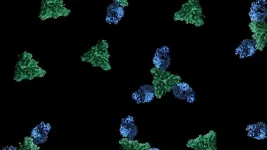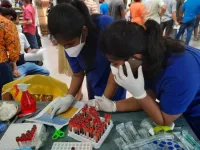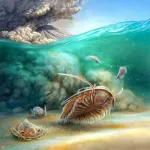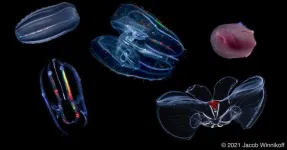(Press-News.org) Ephemeral streams – temporary streams that only flow after rainfall or snowmelt – contribute more than 50% of the flow in downstream river systems and likely have a major influence on water quality across the United States, according to a new modeling study. The findings show how important ephemeral streams are for the transport of water and pollution into larger, more permanent water bodies. Excluding these streams from coverage under the U.S. Clean Water Act, say the authors, would significantly limit federal authority to protect downstream water quality. Ephemeral streams, which flow only in direct response to precipitation and are disconnected from groundwater sources, play a crucial role in transporting nutrients, sediments, pollutants, and other materials to larger water bodies. Although these short-lived streams likely account for much of the global river network, research focused specifically on ephemeral streams is limited, and their hydrological contributions to downstream flow and water quality remain largely unknown. Craig Brinkerhoff and colleagues developed a model to quantify ephemeral stream contributions to more than 20.7 million more permanent water bodies in the contiguous US. Brinkeroff et al. combined data from published hydrological datasets to estimate ephemeral stream locations, and when and how much they flow. The authors found that ephemeral streams in the southwest and western US flow less frequently (only 4 to 46 days per year on average) compared to those in the eastern US, where they flow 173 days per year on average. However, despite their infrequent flow, western ephemeral streams contributed more significantly to downstream river flow – as high as 79% on average – than eastern ephemeral streams, which contributed ~50% on average. Combined, the findings show that ephemeral streams contribute, on average, 55% of the flow to the perennially flowing rivers in the contiguous US. According to Brinkeroff et al., the findings show that ephemeral streams are likely a substantial pathway through which pollution enters rivers, lakes, reservoirs, and ultimately the ocean. “Even though the ephemeral channels are often overlooked because of their infrequent flow, they are critical to downstream water availability,” write Judson Harvey and Stephanie Kampf in a related Perspective. “Climate- and land use-driven changes will alter flows and related functions of ephemeral streams in ways that influence future outcomes for water supply, drinking water quality, and the health of aquatic ecosystems in streams and rivers of all sizes.”
END
Ephemeral streams, often overlooked, are major contributors to US river flow and water quality
2024-06-27
ELSE PRESS RELEASES FROM THIS DATE:
From a Pompeii-like ash burial in Morrocco: Pristine 3D anatomy of Cambrian trilobites
2024-06-27
Thanks to being rapidly entombed in volcanic ash – in a “Pompeii-like” process – Cambrian-age trilobites’ anatomy is more discernable than ever, via exquisitely preserved fossils. The fossils uncovered in Morrocco are reported in a new study that reveals microscopic details including of trilobite appendages and the trilobite digestive system. Trilobites are perhaps the most well-known creatures that lived during the Cambrian Period. These extinct marine arthropods’ hard exoskeleton lends itself to high fossilization potential, facilitating the identification of more ...
Novel epigenic editor, CHARM, enables brain-wide prion protein silencing
2024-06-27
In a new study in mice, researchers introduce “CHARM,” a compact and versatile epigenetic editor that can be used to silence prion protein throughout the brain. The tool provides a path towards an effective first-line treatment for patients with deadly prion disease as well as other neurodegenerative diseases caused by the toxic buildup of unwanted proteins. Prion disease – a suite of devastating neurodegenerative disorders that result in rapid-onset dementia and death – is caused by misfolding of the prion protein, PrP, to form toxic aggregates that result in neuronal death. Previous research in mice has shown that removing PrP ...
A promising weapon against measles
2024-06-27
LA JOLLA, CA—What happens when measles virus meets a human cell? The viral machinery unfolds in just the right way to reveal key pieces that let it fuse itself into the host cell membrane.
Once the fusion process is complete, the host cell is a goner. It belongs to the virus now.
Scientists in the La Jolla Institute for Immunology (LJI) Center for Vaccine Innovation are working to develop new measles vaccines and therapeutics that stop this fusion process. The researchers recently harnessed an imaging technique called cryo-electron microscopy to show—in ...
The most obese children with dengue are more than twice as likely as others to be hospitalized with dengue, according to study of 4,782 10- to 18-year-olds in Sri Lanka
2024-06-27
The most obese children with dengue are more than twice as likely as others to be hospitalized with dengue, according to study of 4,782 10- to 18-year-olds in Sri Lanka.
####
Article URL: http://journals.plos.org/plosntds/article?id=10.1371/journal.pntd.0012248
Article Title: Is the rise in childhood obesity rates leading to an increase in hospitalizations due to dengue?
Author Countries: Sri Lanka, United Kingdom
Funding: This study has been supported by the World Health Organization Unity Studies (GNM and CJ), a global sero-epidemiological standardization initiative, with funding to the World Health Organization and the UK Medical Research Council (GSO). The World Health Organization ...
Prehistoric Pompeii discovered: Most pristine trilobite fossils ever found shake up scientific understanding of the long extinct group
2024-06-27
Researchers have described some of the best-preserved three-dimensional trilobite fossils ever discovered. The fossils, which are more than 500 million years old, were collected in the High Atlas of Morocco and are being referred to by scientists as “Pompeii” trilobites due to their remarkable preservation in ash.
The trilobites, from the Cambrian period, have been the subject of research by an international team of scientists, led by Prof Abderrazak El Albani, a geologist based at University of Poitiers and originally from Morocco. The team included Dr Greg Edgecombe, a palaeontologist ...
Scientists use computational modeling to guide a difficult chemical synthesis
2024-06-27
CAMBRIDGE, MA — Researchers from MIT and the University of Michigan have discovered a new way to drive chemical reactions that could generate a wide variety of compounds with desirable pharmaceutical properties.
These compounds, known as azetidines, are characterized by four-membered rings that include nitrogen. Azetidines have traditionally been much more difficult to synthesize than five-membered nitrogen-containing rings, which are found in many FDA-approved drugs.
The reaction that the researchers used to create azetidines is driven by a photocatalyst that excites the molecules from their ground energy state. Using computational models that they developed, the researchers ...
The worm has turned: DIY lab platform evaluates new molecules in minutes
2024-06-27
Plants are powerhouses of molecular manufacturing. Over the eons, they have evolved to produce a plethora of small molecules — some are beneficial and valuable to humans, others can be deadly. For years, a good way for scientists looking for new medicines to distinguish beneficial plant-derived molecules from harmful ones has been through a scientific sniff test — dab a bit of the molecule at one end of a petri dish and drop tiny nematode worms (C. elegans) at the other, then wait to see if the chemically sensitive worms move toward or away from the compound in question, a process known as chemotaxis.
This “artisanal” ...
Under pressure: How comb jellies have adapted to life at the bottom of the ocean
2024-06-27
The bottom of the ocean is not hospitable: there is no light; the temperature is freezing cold; and the pressure of all the water above will literally crush you. The animals that live at this depth have developed biophysical adaptations that allow them to survive in these harsh conditions. What are these adaptations and how did they develop?
University of California San Diego Assistant Professor of Chemistry and Biochemistry Itay Budin teamed up with researchers from around the country to study the cell membranes of ctenophores (“comb jellies”) and found they had unique lipid structures that allow them to live under intense pressure. Their work appears in Science.
Adapting ...
A CHARMed collaboration created a potent therapy candidate for fatal prion diseases
2024-06-27
EMBARGOED UNTIL 27-Jun-2024 14:00 ET
Drug development is typically slow: the pipeline from basic research discoveries that provide the basis for a new drug to clinical trials to production of a widely available medicine can take decades. But decades can feel impossibly far off to someone who currently has a fatal disease. Broad Institute Senior Group Leader Sonia Vallabh is acutely aware of that race against time, because the topic of her research is a neurodegenerative and ultimately fatal disease–fatal familial insomnia, a type of prion disease–that she will almost certainly develop as she ages. Vallabh and her husband, Eric Minikel, switched careers ...
Researchers find flexible solution for separating gases
2024-06-27
For a broad range of industries, separating gases is an important part of both process and product—from separating nitrogen and oxygen from air for medical purposes to separating carbon dioxide from other gases in the process of carbon capture or removing impurities from natural gas.
Separating gases, however, can be both energy-intensive and expensive. “For example, when separating oxygen and nitrogen, you need to cool the air to very low temperatures until they liquefy. Then, by slowly increasing the temperature, the gases will evaporate at different points, allowing one to become a gas again and separate out,” explains Wei Zhang, a University of Colorado Boulder professor ...



